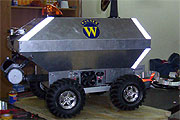Robot claims 'treasure island' booty
NewScientist.com news service
Will Knight
A robotic treasure hunter has laid claim to the find of the century, on the very archipelago that inspired the novel Robinson Crusoe.
The robot, called "Arturito" or "Little Arthur", is said to have discovered the 18th-century buried treasure on the island of Robinson Crusoe - named after the book. The island lies 660 kilometres from the coast of Chile in South America.
A Scottish sailor called Alexander Selkirk was marooned on the island in 1704. His story inspired Daniel Defoe to write Robinson Crusoe in 1729.
The Chilean company responsible for developing Arturito, Wagner Technologies, announced at the weekend that the robot had found the booty by probing 15 metres below ground. The company plans to start excavating in a matter of days, as soon as permits can be obtained.
According to legend, a fabulous treasure haul was buried on the island in 1715 by Spanish sailor Juan Esteban Ubilla-Echeverria. The bounty is said to have been discovered a few years later by British sailor Cornelius Webb, who reburied it on another part of the island.
By some estimates the haul would include 800 barrels of gold ingots, silver pieces, gems and other riches worth up to $10 billion.

[Picture from mindpixel.com ]
Wagner Technologies could not be reached for comment, but the robot Arturito has previously helped Chilean police locate buried weapons using ground-penetrating radar. GPR, or georadar, locates subsurface objects or structures by emitting microwave-frequency electromagnetic radiation and measuring the reflected signal, which is then represented as a two or three dimensional image.
More at Santiago Times Online
New Scientist Breaking News - Robot claims 'treasure island' booty
Will Knight
A robotic treasure hunter has laid claim to the find of the century, on the very archipelago that inspired the novel Robinson Crusoe.
The robot, called "Arturito" or "Little Arthur", is said to have discovered the 18th-century buried treasure on the island of Robinson Crusoe - named after the book. The island lies 660 kilometres from the coast of Chile in South America.
A Scottish sailor called Alexander Selkirk was marooned on the island in 1704. His story inspired Daniel Defoe to write Robinson Crusoe in 1729.
The Chilean company responsible for developing Arturito, Wagner Technologies, announced at the weekend that the robot had found the booty by probing 15 metres below ground. The company plans to start excavating in a matter of days, as soon as permits can be obtained.
According to legend, a fabulous treasure haul was buried on the island in 1715 by Spanish sailor Juan Esteban Ubilla-Echeverria. The bounty is said to have been discovered a few years later by British sailor Cornelius Webb, who reburied it on another part of the island.
By some estimates the haul would include 800 barrels of gold ingots, silver pieces, gems and other riches worth up to $10 billion.

[Picture from mindpixel.com ]
Wagner Technologies could not be reached for comment, but the robot Arturito has previously helped Chilean police locate buried weapons using ground-penetrating radar. GPR, or georadar, locates subsurface objects or structures by emitting microwave-frequency electromagnetic radiation and measuring the reflected signal, which is then represented as a two or three dimensional image.
More at Santiago Times Online
New Scientist Breaking News - Robot claims 'treasure island' booty

0 Comments:
Post a Comment
Subscribe to Post Comments [Atom]
<< Home